by Leland Teschler, Executive Editor, @DW_LeeTeschler
There’s a new movie coming out about the life of Apple’s Steve Jobs. Despite what you might conclude from movies like this one, the birth of new technologies seldom involves much drama. At least that’s the conclusion I’ve come to after reflecting on a talk I attended in 1988 during the International Solid State Circuits Conference (ISSCC).
The ISSCC is considered one of the premier technical conferences for IC design. Papers accepted for presentation there are generally considered either “important” or “interesting.” Twenty-seven years ago, I was among those listening to a paper that I’m pretty sure organizers lumped into the “interesting” category. The main author was a kid from the Massachusetts Institute of Technology who, judging by his demeanor at the podium, was pretty happy to be there. He should have been: The work he described was his master’s thesis. Though it wasn’t even doctorial work, it got selected for ISSCC. That must have been quite a plum.
The kid’s project demonstrated a way of letting ICs communicate with each other wirelessly—single chips couldn’t do that back then. He was thinking about RFID-like applications such as chips embedded in animals (cattle, for example) that could be scanned and identified as they passed through a gate.
The kid went on to describe an IC containing transmission and receive coils. Rather than drive current through the coils, which would consume a lot of power, the chip switched its coil impedance high and low to change, thereby inducing an amplitude modulation in an external magnetic field. The amplitude modulation resulted in a data rate of around 50 kBd.
The research was part of an array of early investigations into wireless topics. Though it was not the basis for future work in the area, a decade or so later the same ideas would gel into both RFID concepts and into a discipline known as near field communication (NFC). NFC is the technology that lets two cell phones exchange information simply by touching each other. The first NFC patents came in the late 1990s when a couple of Brits worked out the details for use in Star Wars toys. Now, of course, NFC is found in mobile payment schemes, such as Apple’s Apple Pay, as well as in more prosaic uses, such as swapping selfies on smartphones. Both RFID and NFC are expected to have big roles in IoT scenarios.
It would have been hard to see that in those pre-world-wide-web days. Back then, there were a lot of refinements necessary before wireless technologies were ready for prime time. For example, NFC schemes now use a frequency shift modulation rather than the AM described in the ISSCC paper. Nevertheless, that early work demonstrated the concept. So you might wonder whether people in that ISSCC audience realized they were seeing the first glimmers of ideas that would eventually become significant communication technologies.
Well, if anybody had those feelings, I certainly couldn’t detect them. The room where the presentation took place was only half full. As I recall, the author got polite applause and fielded a couple of straightforward technical questions after his talk. There were no dramatic moments.
The kid who gave that ISSCC paper, by the way, was Adam Malamy, an engineer who has gone on to work in video compression and decompression. Safe to say, if moviemakers ever decide to put the beginnings of IoT technologies up on the big screen, they’d have a tough time making Adam’s small part melodramatic.
Filed Under: Commentaries • insights • Technical thinking, Wireless devices





Tell Us What You Think!